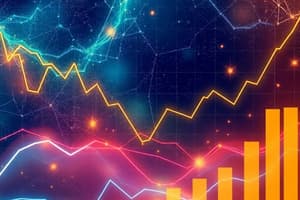Podcast
Questions and Answers
What is the primary objective of macroeconomics?
What is the primary objective of macroeconomics?
- To study the performance of specific industries
- To analyze individual consumer behavior
- To evaluate government policies on local businesses
- To understand the behavior of the entire economy (correct)
Which factor does NOT directly influence aggregate demand?
Which factor does NOT directly influence aggregate demand?
- Net exports
- Labor force participation rate (correct)
- Investment spending
- Government spending
How is economic growth typically measured?
How is economic growth typically measured?
- Changes in nominal GDP
- Changes in real GDP (correct)
- Changes in the unemployment rate
- Changes in consumer price index
What does inflation indicate in an economy?
What does inflation indicate in an economy?
Which of the following best defines gross domestic product (GDP)?
Which of the following best defines gross domestic product (GDP)?
What type of unemployment occurs due to economic downturns?
What type of unemployment occurs due to economic downturns?
What does the interaction of aggregate demand and aggregate supply determine?
What does the interaction of aggregate demand and aggregate supply determine?
Which of the following is a component of fiscal policy?
Which of the following is a component of fiscal policy?
What is the primary objective of contractionary fiscal policy?
What is the primary objective of contractionary fiscal policy?
Which factor does NOT typically influence economic growth?
Which factor does NOT typically influence economic growth?
Which phase of the business cycle is characterized by a decrease in economic activity?
Which phase of the business cycle is characterized by a decrease in economic activity?
What is the central bank's main goal concerning economic policy?
What is the central bank's main goal concerning economic policy?
What is a key component that influences exchange rates in international trade?
What is a key component that influences exchange rates in international trade?
What primarily drives demand-pull inflation?
What primarily drives demand-pull inflation?
Which statement is true about policy debates in macroeconomics?
Which statement is true about policy debates in macroeconomics?
What are the primary concerns when measuring inflation?
What are the primary concerns when measuring inflation?
Flashcards
Macroeconomics
Macroeconomics
The study of how the entire economy functions, focusing on large-scale economic phenomena like inflation, unemployment, growth, and business cycles.
Gross Domestic Product (GDP)
Gross Domestic Product (GDP)
The total market value of all final goods and services produced within a country's borders in a specific period.
Inflation
Inflation
A sustained increase in the average price level of goods and services in an economy over time.
Unemployment
Unemployment
Signup and view all the flashcards
Economic Growth
Economic Growth
Signup and view all the flashcards
Aggregate Demand (AD)
Aggregate Demand (AD)
Signup and view all the flashcards
Aggregate Supply (AS)
Aggregate Supply (AS)
Signup and view all the flashcards
Fiscal Policy
Fiscal Policy
Signup and view all the flashcards
Monetary Policy
Monetary Policy
Signup and view all the flashcards
Economic Development
Economic Development
Signup and view all the flashcards
Business Cycles
Business Cycles
Signup and view all the flashcards
International Trade
International Trade
Signup and view all the flashcards
Study Notes
Introduction to Macroeconomics
- Macroeconomics studies the entire economy, not individual markets.
- It focuses on large-scale phenomena like inflation, unemployment, economic growth, and business cycles.
- Macroeconomics aims to understand factors influencing aggregate output, income, employment, and the overall price level.
- It analyzes relationships between variables like consumption, investment, government spending, and net exports to understand their impact on the whole economy.
Key Concepts in Macroeconomics
- Gross Domestic Product (GDP): The total market value of final goods/services produced within a country's borders in a specific time period, measuring economic output.
- Inflation: A sustained rise in the average price level of goods/services.
- Unemployment: The percentage of the labor force actively seeking employment but unable to find jobs; types include cyclical, frictional, structural.
- Economic Growth: An increase in the production of goods/services, often measured by changes in real GDP and related to productivity improvements, investment, and technological advancements.
Aggregate Demand and Aggregate Supply
- Aggregate Demand (AD): Total demand for goods/services at a specific price level and time. Factors include consumption, investment, government spending, and net exports.
- Aggregate Supply (AS): Total supply of goods/services at a given price level and time. Factors include input costs, technology, and resources.
- AD and AS interact to determine equilibrium price and output; shifts in either curve affect macroeconomic equilibrium.
Fiscal Policy
- Fiscal policy uses government spending and taxation to influence the economy.
- Government Spending: Expenditures on public goods/services (e.g., infrastructure, education, defense).
- Taxes: Affect disposable income and influence consumer spending and investment.
- Expansionary fiscal policy (increased spending/lower taxes) stimulates activity, often during recessions. Contractionary policy (reduced spending/higher taxes) aims to curb inflation.
Monetary Policy
- Monetary policy uses central bank actions to manage the money supply and interest rates to influence the economy.
- Interest Rates: Regulate borrowing costs for businesses/consumers, affecting investment and consumption.
- Money Supply: Impacts inflation and growth; central banks control through actions (e.g., open market operations).
- The main goal of central banks is usually price stability and full employment.
Economic Growth and Development
- Economic growth is the increase in the production of goods/services. Influenced by factors like technological advancements, human capital, and capital accumulation.
- Economic development is a broader concept encompassing growth and improvements in living standards, education, and infrastructure.
Business Cycles
- Business cycles are fluctuations in economic activity around a long-term growth trend.
- Phases include expansions, peaks, contractions, and troughs.
- Understanding cycles is important to predict/mitigate downturns and develop effective macroeconomic policies.
International Trade and Finance
- International trade is the exchange of goods/services across borders.
- Exchange rates and trade imbalances are crucial in international macroeconomics.
- Trade policies (e.g., tariffs, quotas) affect the flow of goods/services between countries; balance of trade (exports - imports) is significant.
Unemployment and Inflation
- Unemployment has various causes, including lack of demand or structural mismatches.
- Inflation can be caused by excessive demand (demand-pull) or rising production costs (cost-push).
- Managing both unemployment and inflation are key macroeconomic policy goals.
Policy Debates in Macroeconomics
- Debates center on the effectiveness and desirability of different policies. Examples include active vs. passive fiscal policy, the role of government spending, inflation targeting, and the optimal mix of monetary and fiscal policies.
Studying That Suits You
Use AI to generate personalized quizzes and flashcards to suit your learning preferences.




